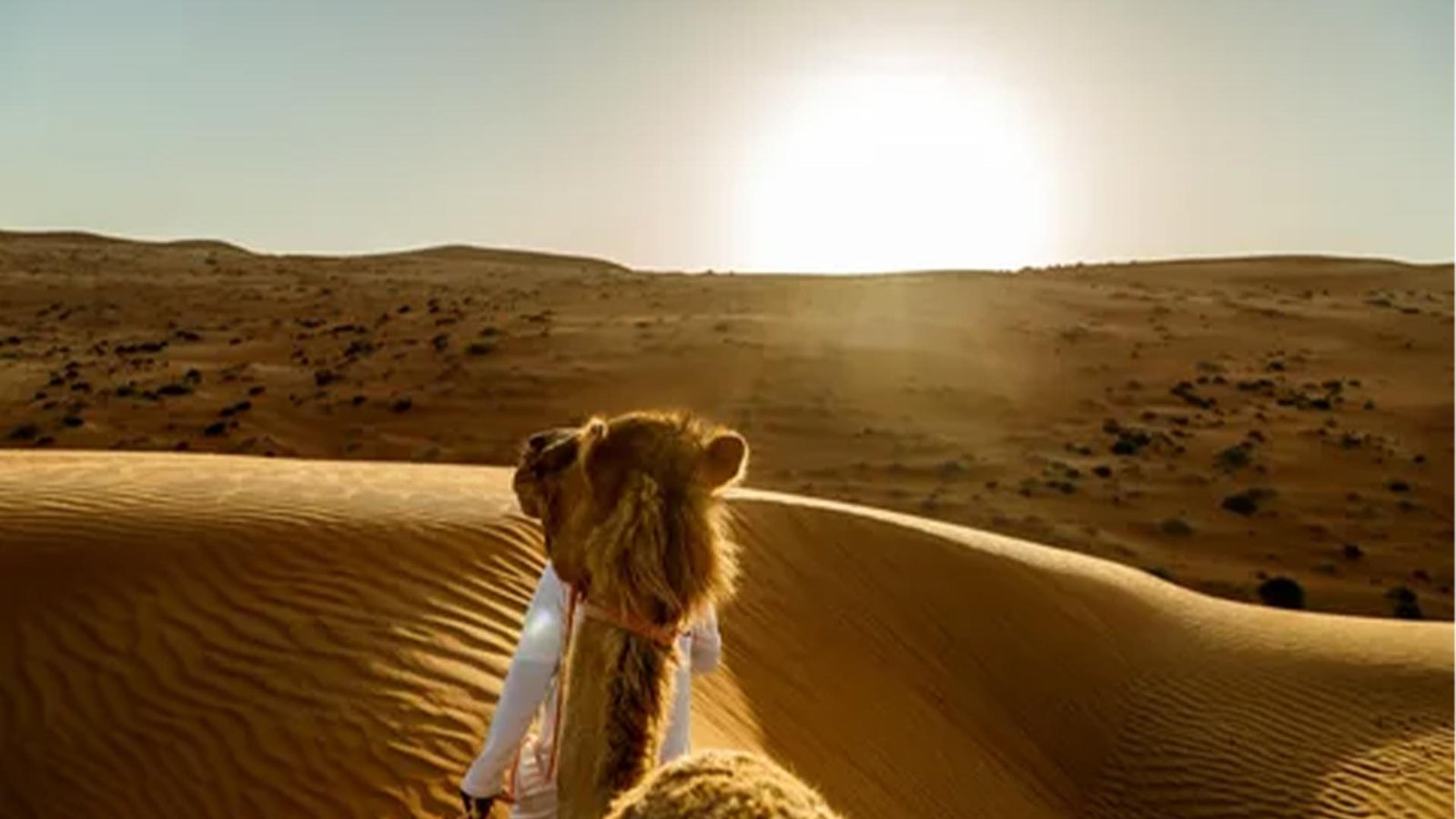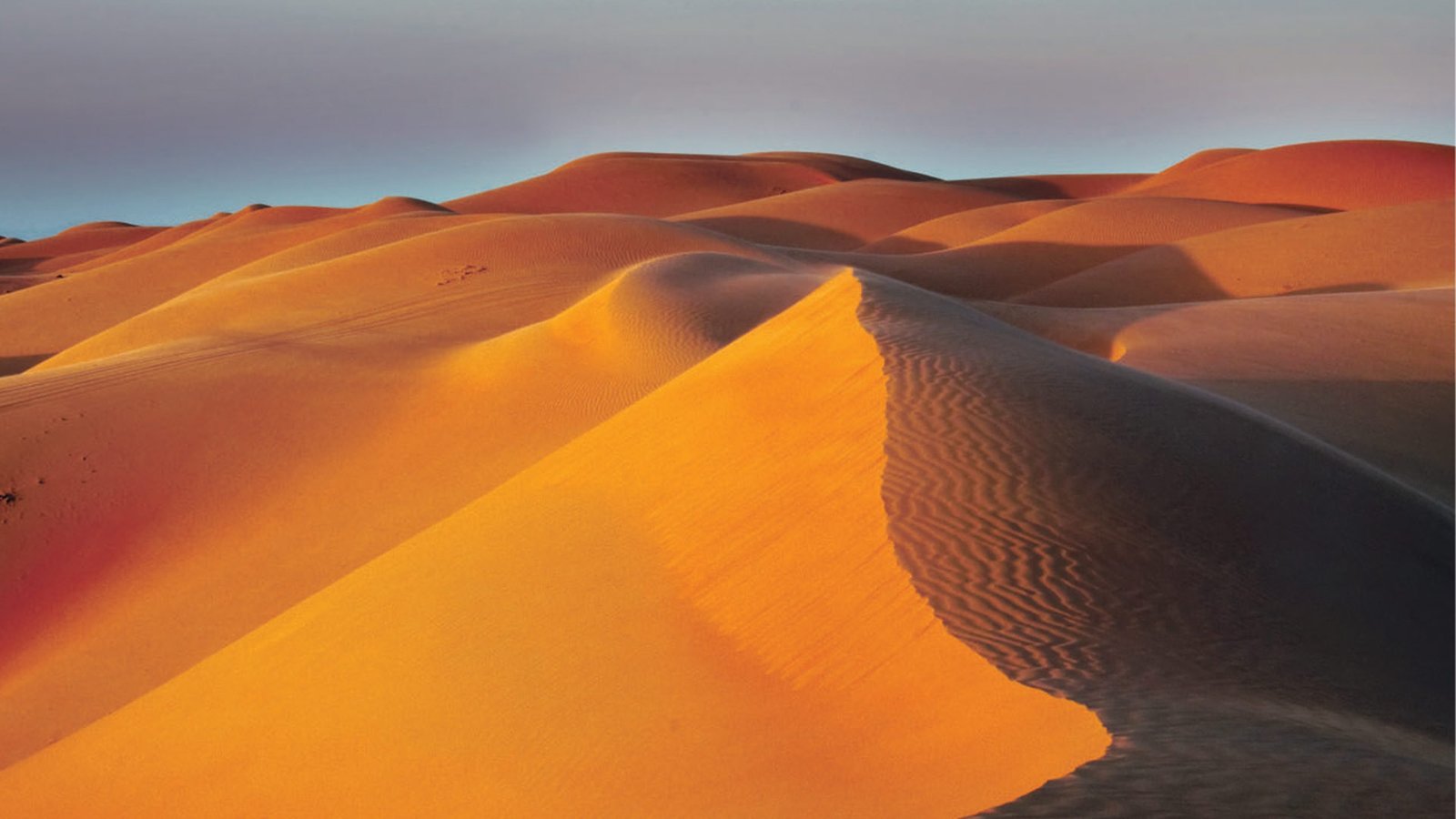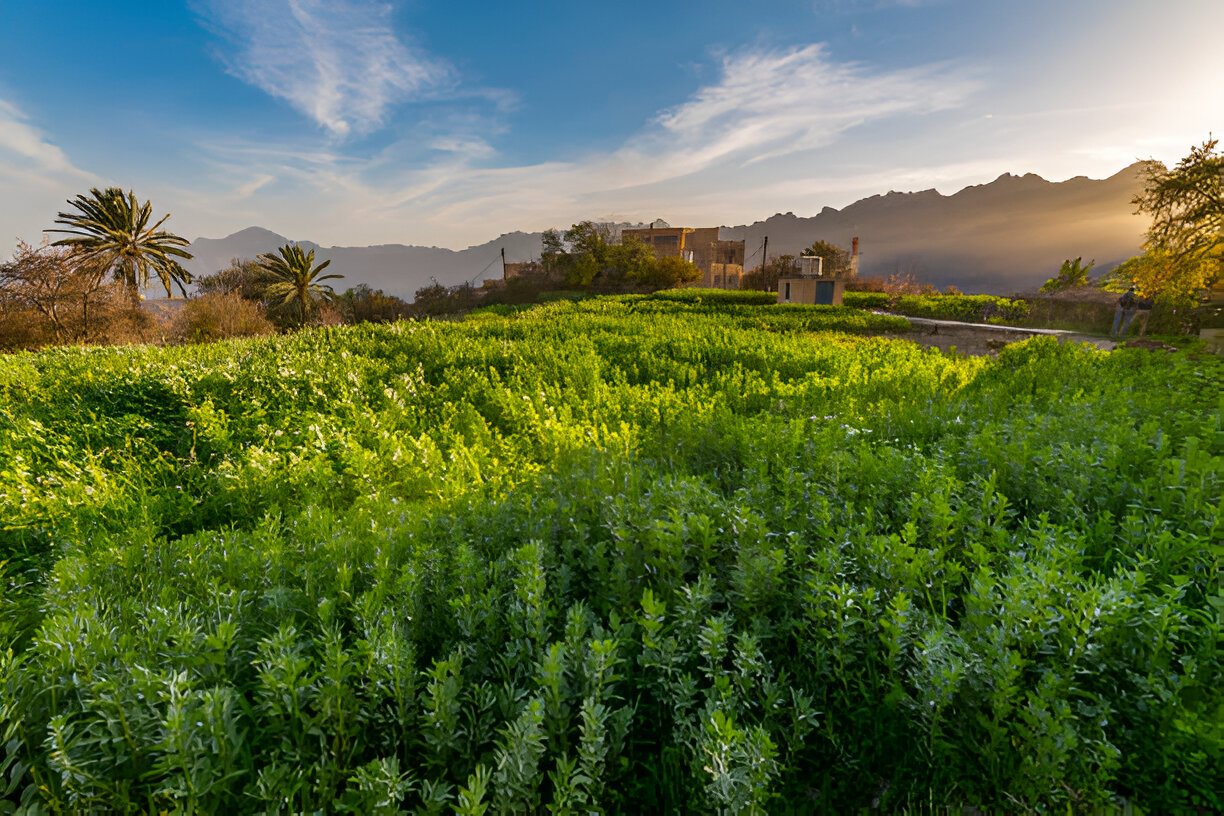

You are in Wahiba Sands, Oman’s most fascinating desert area. There are many activities to participate in Wahiba Sands, as it is the heart of the Arabian Region due to these golden sands, camel riding, and Bedouin’s old traditions. Let us take you through the desert and the thrilling adventures, the cultural experiences, and, of course, practical travel tips.
Life in the Wahiba Sands Oman is not so monolithic but remains stagnant amidst shifting sand and skies. The desert’s features are constantly molded by the wind, which constructs the dunes that migrate and change through different periods of the year. The sky-high dunes that are larger than 100 meters are the elements of the showy and unpredictable landscape. There is a variety of plants and animals that have adapted to live in an environment with no water supply, such as the Arabian Oryx, lizards, and insects.
The extreme conditions in Wahiba Sands Oman consisting of the sun’s burning rays during the day and the cold at night are described by the writer. It can be exceptionally hot in the summer, with temperatures reaching above 40°C (104°F), and on the other hand, as cold as just over freezing in the winter. The desert’s environmental composition, lack of rain, and desertification give way to a unique ecological system where each animal and plant has uniquely evolved to live in the environment.
Wahiba Sands Oman is different from the rest of the desert because of its blend of beautiful natural landscapes and rich cultural heritage. Wahiba Sands’ endless golden dunes of sand are a delightful sight to the eyes of the photographer, who can find countless picture-perfect views. The sand is in motion; It is making a maze of patterns and textures, and it changes from morning to evening, giving the artist a perfect idea to take photos of their adventure.
Despite the beautiful view of Wahiba Sands, the place is not just scenery; it is also held together by the population that calls this desert its home. The Bedouin tribes who inhabit this territory have a valuable ethnic heritage that is tightly interwoven with the desert. Their indigenous mode of existence, consisting of their etiquettes, food, and handiwork, gives the desert a distinct character that you can’t find elsewhere.

Riding a camel is a must when desert is experienced. The desert inhabitants owed slaves of these exotic animals in travel for a long time, and Wahiba Sands Oman only intensified the era of glory of riding on one. Through the calm, impressive walk of the dromedary in the sand, a peaceful tune covers the entire desert, and the tops of the remarkable animals can be enjoyed with great prospects.
There are a few bones of contention about the level of tourism. Camel rides in Wahiba Sands Oman are sold by many operators and include short casual rides along leisurely on the steeper inclines, which could be utilized for a good workout. By the way, the tours also offer sunset or sunrise rides; you can almost classify the experience on the dunes with the sun as something close to that of the miraculous creation of gold from the sand. Those who want to enjoy the place thoroughly can enjoy the overnight camel treks, which bring them to the very heart of the desert, where the sky’s canopy would be their flash and they would relive the peacefulness of the desert nights.
For extreme sports enthusiasts, sandboarding is the perfect adrenaline-pumping activity. Dunes can be downhill snowboarding charts as well as sandboarding, involving sliding down the slopes in the sand with the help of boards for skiing bumps. It’s a mix of adrenaline and visual experience, really—the speed that it brings together with the beauty of the desert.
Also, it may, however, seem a bit challenging to climb another hill when you are already on the top of one. Sandboarding at Wahiba Sands Oman is open to all skill levels, from beginner to pro; however, kids and pros are equally welcome. Most bamboo skateboarders offer superfine-quality branded bamboo skateboards that can withstand medium to high speeds and come with dark wheels and instructions on usage. The morning hours, when the sand is as warm as it can be, when the sun is shining above and the dunes are near at hand, and the evenings when people go about their daily lives under the same kind of sky, are the best times for sandboarding.

If you desire an exciting experience in the desert, 4×4 off-road rides are definitely for you. With these tours, you will cross the very challenging Wahiba Sands Oman, some of which are steep dunes and challenging landscapes. The exhilarating experience of charging up and down dunes, as well as being in a breathtaking desert panorama, lends itself to an indelible impression on the visitor.
4×4 trips come in different shapes and sizes, some that are very short and others that last the whole day and thereby go into the desert more deeply. Most of the tours incorporate a stop-off, visiting several vantage points from where you may capture the view of the landscapes and the high dunes. For a glamorous weekend trip, you should try the combo deal that includes sandboarding and a 4×4 ride.
Making it, Muscat can’t miss the desert journey it goes along. This desert place is approximately two hundred kilometers southeast of Muscat, the capital of Oman. There are several ways to get there:
By Car: Renting a 4×4 vehicle is one of the most popular options. The drive from Muscat takes about 2 to 3 hours and consists of both paved and unpaved roads. To avoid a desert disaster, check if your vehicle is the least equipped for this location, as you’ll have to traverse hilly and uneven ground.
By Tour: Many tour operators in Muscat offer guided tours to the Wahiba Sands Oman. These tours often include transportation, a guide, and various desert activities. The best choice will be a tour that is the least stressful so that you can get the most out of your vacation.
By Public Transport: Though very seldom, there are public buses that drive from Muscat to the nearby towns. You then only have to book a taxi or a shuttle to go the rest of the way to Wahiba Sands Oman.
Accommodation in Wahiba Sands ranges from traditional Bedouin camps to luxury desert lodges. Here are some options to consider:
Visiting the Wahiba Sands is a moment not to be missed when it is possible to get deeper into Bedouin culture. These people have lived here for centuries, and their way of life is geared towards a respectful use of natural resources.

Wahiba Sands provides a wide range of activities and attractions, catering to the needs of different people:
Sunset and Sunrise Views: Sunrise and sunset light up the desert landscape. The varying shadow configurations of the light, the light and dark areas, and the different tones such as dark and light are the elements that make the dunes more attractive. Take a blanket and a picnic basket with you, or just spread a blanket and relax while relishing the good view.
Desert Photography: The ever-changing landscapes of Wahiba Sands Oman are a photographer’s dream. Shoot the different patterns of the dunes, the interplay of light and shadow, and the lively colors of the desert.
Local Markets: One should visit the local markets and souks in nearby towns to experience the vibrant culture of Oman. These markets offer a range of goods, including spices, textiles, and traditional crafts.
Camping in Wahiba Sands means getting ready for some of the things that will ensure your comfort and your enjoyment. The tips are as follows:
Pack Wisely: Don’t forget the necessities such as a wide-brim hat, sunscreen, glasses, and light, breathable uniforms. The weather can be different from day to night, so to get warm at night, many layers should be packed.
Stay Hydrated: The dryness of the desert atmosphere can be the main reason for a fast dehydration process. Have enough water brought along and take sips of water all the time.
Footwear: Sturdy, comfortable shoes must be worn for walking in sand. Face protection garments are needed for desert walking rain.

Respect for the state of the environment and the rules of conduct is crucial to staying in Wahiba Sands Oman.
Leave no trace: Follow the Leave No Trace principles, which advocate the practice of proper dumping of waste while, at the same time, minimizing harm to the environment.
Respect local customs: be mindful of the cultural traditions of the Bedouins and the customs of the country. If you are visiting the local communities, ask the ones in charge for permission before taking any pictures, and respect the guidelines given by the hosts.
There are quite a few features to visit, and the varied landscape is offered in full blossom by the following main attractions at Wahiba Sands Oman:
The Great Dunes: Wahiba Sands’ magnificent dunes are the most remarkable features. Pick a trek or take a 4×4 ride to cover these enormous geological features.
Al Waha is a place where one can enjoy desert life and mingle with animals in the wild.
Barbeque Point: Barbeque is very popular on the sandy beaches of Wahiba, especially during the season of holidays. These places are the best locations to capture moments in the scorching landscape under the mountains.
Wahiba Sands has a range of services and facilities that will enrich your stay:
Tour Operators: In Wahiba Sands, you can find many tour operators providing guided tours and activities to travelers. These trips can be personal and comprise camel riding, sandboarding, and cultural components.
Visitor Centers: It is possible to find some visitor centers in different parts of the desert that will provide you with information, maps, and tips on desert exploration.
Local Shops: In and around Wahiba Sands, small shops and stalls are crowded with souvenir items, snacks, and even useful stuff.
The Bedouin people are the very lifeblood of the cultural narrative of Wahiba Sands Oman. An interlaced blend of their heritage, lifestyle, and background with the desert ecosystem defines their spirituality.
Traditional Life: They cope with the region’s tough environment by practicing a mobile lifestyle that enables them to move from one pastoral area to another, using seasonally varying sources of water. Their tents, known as “Beit Sh’aer,” made the old way by using goat hair, are the only homes they have.
Language and Music: The Bedouin dialect of Arabic is a poetic expression of their traditional songs that are very rich in music. Often, the music is a side feature of their cultural festivals because of the instruments such as the “oud” (a stringed musical instrument) and “rebab” (a kind of fiddle).
Wahiba Sands is an event site for many interesting happenings and traditional festivals that give a glimpse into Bedouin merriment.
Camel Racing: The activity that is called camel racing has been known as the most popular and traditional sport in the country. Not only can people attending the events see these beautiful animals running, but they can also feel the rush of the ultimate fight starting a long time ago.
Cultural Festivals: When realizing their events, the local people traditionally (music, dance, and making traditional crafts) celebrate Bedouin heritage. These events are the best chance to get involved in the strong connectedness of cultural aspects of the region.

The dunes of Wahiba Sands Oman are a desert’s masterpiece. These gigantic dunes form a spectacle that is so stunning that it is both delightful and intimidating at the same time.
Dune Hiking: The trek up and down the dunes not only gives you the feeling of being fully inside the desert but also enables you to realize that the desert is one vast area of awe-inspiring and bewildering sights. The winds push the shifting sands from one place to another and back again. The terrain is beautifully dynamic; every step you take leaves a new track.
Dune Photography: Take photos of the dunes that show their beauty from above. By the way, it is also a great way of dealing with the problem of airplane wingtips getting into your photos. The way the sun moves in the sky causes the dunes to make spectral visions change and change over, and for a few hours, you can take a photo, giving you different pictures for each time of day you are there.

To obtain the perfect photos of the dunes, you have to remember these tips:
Golden Hour: Golden hours are the best times of day when the sun is near the horizon. Plus, the cloudy sky will enhance the sunlight’s magical effect a lot. The light is mellow, and the texture and colors of the sand are coming out.
Use a tripod: A good tripod can make the camera steadier and less likely to be moved. This is where the use of the tripod comes in. With its help, you can take surprisingly sharp images.
Experiment with Angles: By changing the angle of the camera, you can take almost all the curves of the dunes in one photo. In contrast, when the angle is higher, the dunes will look smaller, therefore providing a wide view. There are also numerous ways of looking at the dunes.
It is very important to plan carefully while packing for a desert trip if you aim to enjoy the time spent and guarantee safety throughout the journey.
Sun Protection: The heat and sun in the desert can be cruel, so take long-sleeved shirts, hats, sunglasses, and sunscreen to protect yourself from UV rays.
Clothing: Opt for lightweight, breathable clothes that will cover your skin to shield you from sunburn and sweat. Temporarily adding or removing clothing will keep you cool in warm and cold temperatures.
First Aid Kit: A basic first-aid kit that includes bandages, antiseptics, and any personal drugs one might need should be your first-aid kit.
Moving along the Wahiba Sands Oman can be difficult, not only because the sands change but also because they are so distant from everything else.
Maps and Navigation: During your trip to the desert, you should go with credible maps and GPS devices to aid you in navigation. Acquaint yourself with crucial landmarks and roads first.
Hire a Guide: When deserts are unfamiliar to you, the best way to be safe is to hire a local guide. They can offer insightful knowledge and ensure safe passage through the desert.
Although the dunes are the main attractions, Wahiba Sands has a few other spots that are of interest:
Local Villages: Travel to the local villages in the vicinity of the dunes to enjoy a day of traditional Omani life. These villages act as an entry point where you can get a taste of the local culture and customs.
Historical Sites: Check out the old ruins, towers, and cemeteries all over the place from the Sinaw region and get a history lesson from Oman’s millions of years.
Picking the best safari in Wahiba Sands can make your trip even better.
Types of Safaris: They take place at different times of the day—early in the morning, around noon, and at sunset. Every safari has its particular points of interest, which allow the visitor to better explore different parts of the desert.
Duration and Activities: Some safaris can seem to take just a few hours of the whole day, while others can be an overnight trip. Be sure to decide which sightseeing journeys include activities like camel rides, sandboarding, and cultural visits.
In Wahiba Sands Oman, you can enjoy a desert safari, which will let you have a lovely mix of excitement and fun.
Activity Highlights: Dune bashing, sandboarding, and other adventurous activities will be coupled with taking some time to soak in the beauty of the desert.
Comfort and Safety: The modern safari vehicles feature air conditioning and safety belts, providing a comfortable and safe trip. The guides are well-trained to make the activity run smoothly, and everyone has a pleasant experience.
Wahiba Sands Desert Oman boasts various tours to suit the interests of a diverse clientele:
Guided Tours: These are the ones that come with a trained guide who can talk you through the nature and culture of the desert. These are mainly transportation, activities, and meals.
Self-Guided Tours: Those who want to be alone and against guided tours can opt for self-guided ones where you are free to go at your own pace. Be sure you can have the maps and navigation instruments you require, as you would need them if you chose this option.
Whether you go on a planned or a go-with-the-flor excursion primarily depends on what you want:
Guided Tours: These are the most beneficial for anyone who aims to see the whole thing with no hassle. The guides provide the most current information and care for the logistics.
Self-Guided Tours: They are best suited to those who need restorations and want to be themselves. Here, you will have to go through the rigors of preparation and navigation but will have a memorable experience.
The best time to visit Wahiba Sands falls between October and March. Between these months, the temperature is cooler and more refreshing, so you can easily complete outdoor activities.
Adrenalin-inducing temperatures and low medical facility availability are some of the safety concerns. Make sure you have proper gear for the desert and strictly observe this camping etiquette.
Yes, many Bedouin camps and tourist facilities offer vegetarian options. Just let your host know of your diet requirements and inform the tour operator; therefore, the necessary arrangements can be made before the trip.
Never miss any important news. Subscribe to our newsletter.








Never miss any important news. Subscribe to our newsletter.
Copyright 2024 All About Oman. All rights reserved.